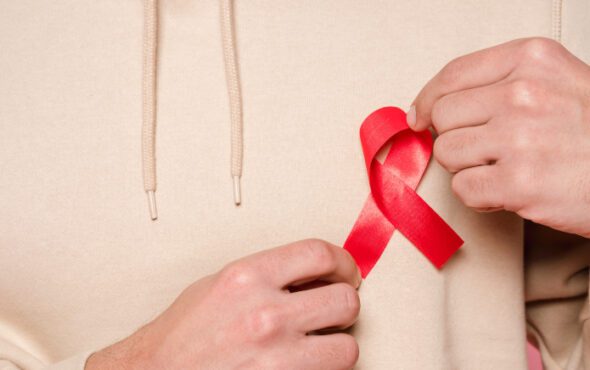
In the 20 years since U.S. President George W. Bush launched the world’s biggest investment to fight HIV/AIDS, the fund has had a “dramatic and life-saving impact”, UNAIDS U.S. liaison office director Vinay Saldhana told Openly.
The U.S. government says it has invested more than $110 billion through the President’s Emergency Plan for AIDS Relief (PEPFAR) and The Global Fund to Fight AIDS, Tuberculosis and Malaria, and saved 25 million lives and prevented millions of HIV infections.
But the programme is now under threat after Congress in October renewed its funding for only one year, instead of the usual five.
What prompted the investment?
When PEPFAR was introduced in 2003, 40 million people were living with HIV/AIDS globally, and 20 million had already died from the virus, according to UNAIDS.
In sub-Saharan Africa, where two-thirds of cases were found, infection rates were “rampant”, the United Nations 2003 AIDS Epidemic Update said.
PEPFAR was introduced as a five-year funding programme in 12 African and two Caribbean countries with the goal of providing antiretroviral treatment (ART) to 2 million people living with HIV/AIDS, preventing more infections and providing care for 10 million children and vulnerable people.
What countries is PEPFAR active in?
PEPFAR now operates in 55 countries, having expanded into Asia, South America and eastern Europe.
Now, those 55 countries, Saldhana said, are “the furthest ahead in the global response to HIV.
What has the impact been?
Less than a decade into PEPFAR funding, in 2012, the UN said an end to the worldwide AIDS epidemic was in sight, crediting better access to treatment and prevention drugs.
Since 2010, new HIV infections have been reduced by 57% in PEPFAR-funded countries, compared to 38% in all other countries, according to UNAIDS.
“It really shows in practical, numerical terms the dramatic and life-saving impact of PEPFAR,” said Saldhana.
In the 20 years since PEPFAR launched, 20.1 million people have received sustained access to antiretroviral treatment through the programme, representing two-thirds of the total number receiving ARTs by the end of 2022, according to UNAIDS.
PEPFAR has also helped to ensure 5.5 million babies were born HIV-free, according to the U.S. State Department, which administers the programme.
By the end of 2022, 39 million people worldwide were living with HIV/AIDS, and 76% of them have access to treatment.
What are the 95-95-95 goals?
Thirteen countries funded by the programme have reached the UN’s ambitious “90-90-90” target for 2020, which aimed to ensure that 90% of people living with HIV know their status, 90% of those diagnosed receive ART, and 90% of those receiving ART show viral suppression.
The goal for 2025 is to reach 95% for those same measures. Five PEPFAR-funded countries — Botswana, Eswatini, Rwanda, Tanzania and Rwanda — have already met those goals, according to UNAIDS data.
What is the future of fighting HIV/AIDS?
UNAIDS’ target for ending the disease as a public health threat is 2030. A number of countries, particularly in Africa, are on track, or close to their targets.
But there are challenges ahead. Infections are on the rise in eastern Europe and north Africa, and even in countries that have made huge strides, there are groups being left behind as a result of stigma and criminalisation of LGBTQIA+ people and sex work. UNAIDS data show transgender people, sex workers and men who have sex with men face barriers to accessing prevention and treatment services.
Saldhana said he was “very concerned” that LGBTQIA+ Ugandans’ access to HIV/AIDS services may get “significantly worse” after the country passed a strict anti-LGBTQIA+ law in May.
What is the future of PEPFAR?
There had been broad bipartisan support in Congress to extend the programme five years at a time, but this year, opposition from some conservative Republican lawmakers meant it only received one year of funding.
Republican opponents of abortion came out against a five-year funding reauthorisation unless it barred nongovernmental organisations that used any PEPFAR funding to promote or provide abortion services.
U.S. laws prevent such funding for abortion services and the U.S. State Department say PEPFAR does not fund or provide abortion services.
While Saldhana said the programme was still functioning “exceptionally”, he said the uncertainty over future funding had impacted work on the ground.
“One of the questions we get asked most often is, how can we as partner countries as programme countries continue to prioritize HIV when we don’t know if we can count on the U.S. government for support for the next five years?”
Saldhana is particularly concerned as other donors have scaled back their commitments.
“We cannot let complacency be the enemy of continued progress in the global HIV response,” he said. This story is part of a series supported by HIVOS’s Free To Be Me programme.
Reporting by Sadiya Ansari.
GAY TIMES and Openly/Thomson Reuters Foundation are working together to deliver leading LGBTQIA+ news to a global audience.



